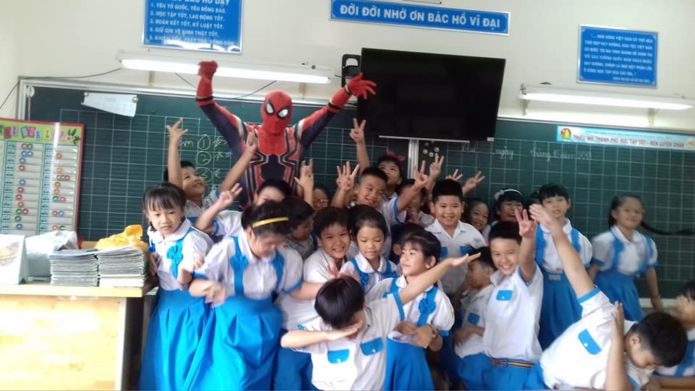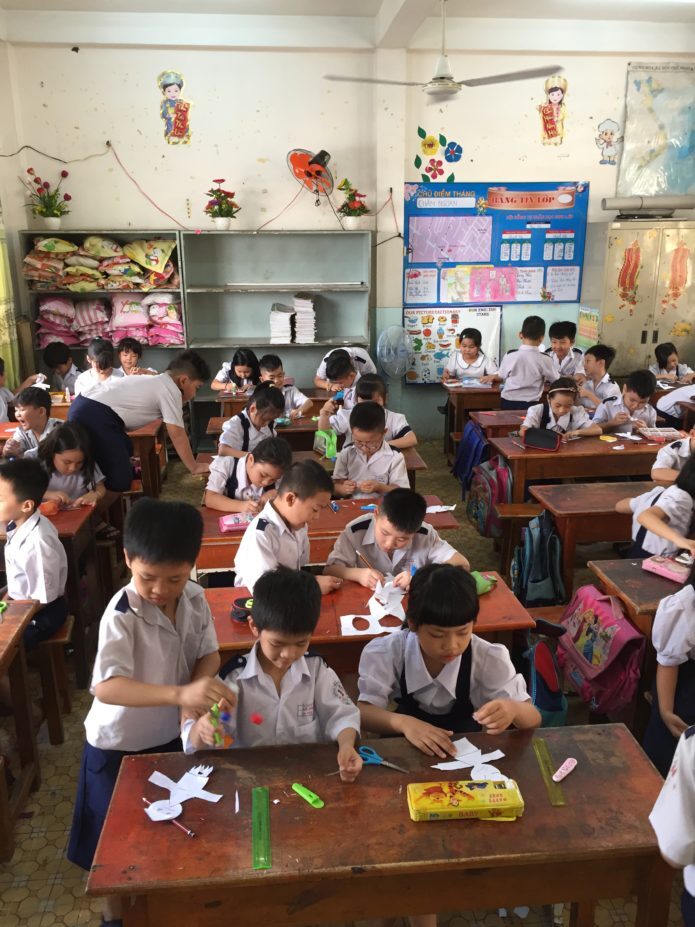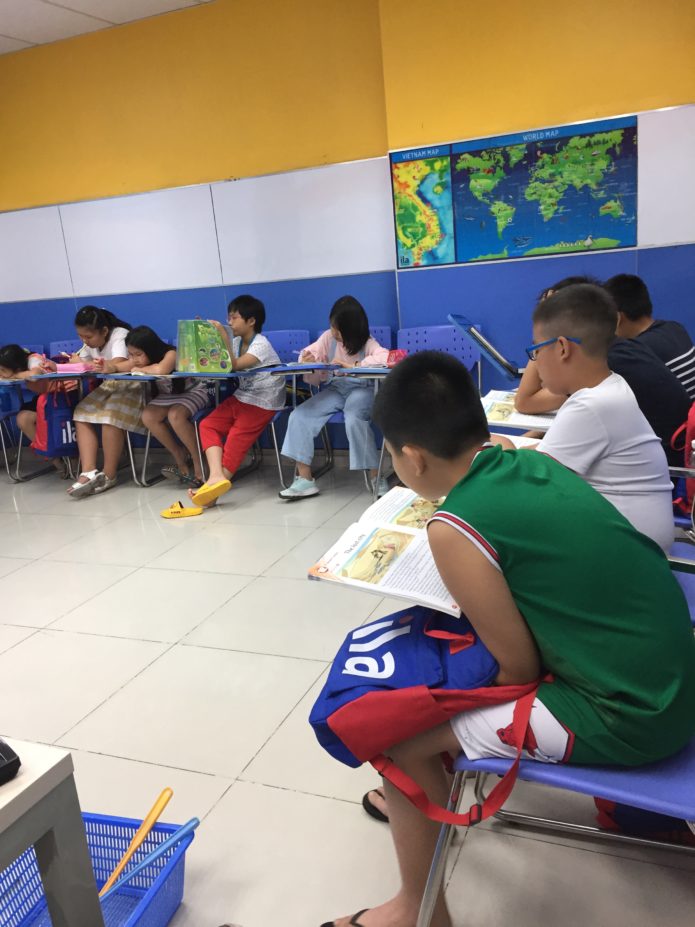Teaching English in Vietnam is definitely our fastest growing program, and it’s very easy to see why: The country is beautiful, with a unique culture and very low living costs. Ho Chi Minh City, the biggest city, offers a few options when it comes to teaching English.
Parker, a TravelBud participant from the US, shares with us below, what he has discovered about teaching English in Ho Chi Minh City, Vietnam. Particularly focusing on public schools and private language centers where he teaches at both.
Interested in teaching English in Vietnam? We'll send you more info!
Hello! My name is Parker, I’m a teacher in Ho Chi Minh City Vietnam, and I love being an English teacher in Vietnam. I can honestly say that this is the best job I’ve ever had. I'm assuming that if you’re reading this blog post, you're curious about teaching in Vietnam, and may be actively considering teaching in public school or private language center classes. In an effort to help you make that decision easier, I am going to give as much detail as possible about the daily teaching schedule in both public schools during the day and language center classes in the evening.
 A group of soon to be teachers during their in-country TESOL course orientation in Ho Chi Minh, Vietnam.
A group of soon to be teachers during their in-country TESOL course orientation in Ho Chi Minh, Vietnam.
A bit about me
A little background about me: I'm 28 years old, I come from Atlanta, Georgia, in the USA, I studied history, international relations and sociology at the University of Georgia, and I previously taught English as a foreign language in China and Thailand. I did my TESOL course with TravelBud in Vietnam and I've been teaching in Ho Chi Minh City full time since September 2018.
By my own estimation, I see about 1000 students between Monday to Friday across 5 different schools. I am one of the hundreds of native English-speaking foreigners who do this in Ho Chi Minh City, and I’m one of 60 teachers in my office who do this style of public school teaching across primary (grades 1-5) and secondary public schools (grades 6-9) in Go Vap District, which is about 7 kilometers north of the central business district (District 1) of Ho Chi Minh City. Go Vap is densely populated and has significantly fewer foreigners in it than other city districts.
 During the school holidays, we get a chance to travel around Vietnam and other southeast Asian countries. Here we're at a music festival right on the beach!
During the school holidays, we get a chance to travel around Vietnam and other southeast Asian countries. Here we're at a music festival right on the beach!
There’s a lot of variety in public school English education, not just in Vietnam but across Southeast Asia. If you were to teach in Thailand (one of the two countries I taught in prior to Vietnam), you would most likely be at the same school all day, and see the same kids in and out throughout the week, perhaps even with your own classroom. You are a full and equally respected teacher at that school and thus required to stay all day, attend meetings, ceremonies, etc.
In my particular job right now, I drop into various classrooms once a week throughout this particular school district. I teach both public school classes and (1) private language center class on Tuesday and Thursday evenings. I am primarily a public school teacher, and I prefer it over the private language classes. With that said, most teachers say they prefer private classes, and for good reason. Private language center classes have much smaller class sizes, there’s air con, use technology like computers internet videos and smart boards, and loads of games and physical resources like sticky balls, paper, softballs, etc.
Teach Abroad Destination Idea: Vietnam
Our Teach English in Vietnam program is one of the most rewarding experiences one can embark on. It has an incredibly relaxed teaching environment allowing you to take time off for your travels, high salaries ($1200-$2000) and low cost of living making saving an absolute breeze. Many expats use teaching English in Vietnam is their base to travel through southeast Asia. Check out what life would be like for you teaching English in Vietnam in our video below:
Interested in Teaching English, volunteering or interning abroad? We'll send you more info!
The big differences between private language centers and public schools in Vietnam
 Just another day of teaching English in Vietnam. My class has me dressed as Spiderman for the day.
Just another day of teaching English in Vietnam. My class has me dressed as Spiderman for the day.
I only visit each class for 35, 70 or 90 minutes a week depending on the contract drawn between the individual school and my employer. I know very few of these students names, although I’m quite good with faces, and I remember who is a stronger student, who is shy, who is quick to cry, to bully, to be a good or bad sport in a game. Some students who go to private classes have adopted an English name and are proud of it, some of them just want you to know their name, so I try the best I can to remember these students names. My particular company pays more for classes taught in public school because of the early mornings, the travel, and large classes with no air con.
Flexibility vs pay
The money is nice, and I prefer it over the heavy nights and weekends schedule you get if you work primarily or totally in language centers. Some perks I enjoy about my heavy public school schedule: I can come and go from the schools as I please so long as I’m meeting my obligations to the students, I can run for a coffee during the break, leave for lunch, run to my office for lesson planning or home for a nap, whatever I want so long as I am prepared and in class when I’m scheduled to be there, I’m not obligated to do any kind of office hours or forced to stick around the public school all day, which is a huge perk for me and the way I prefer to organize my day.
Language center vs public vs private schools
If you teach in Vietnam, you will typically be employed in one of three possible settings: 1. public school, via a language center that acts as the intermediary between you and the school administration, 2. private language center classes, or 3. as a teacher in an international school or academy.
 Teaching English in Vietnam allows one to get out of their comfort zone and most importantly allows one to embrace a completely new culture.
Teaching English in Vietnam allows one to get out of their comfort zone and most importantly allows one to embrace a completely new culture.
The last option may sound the most appealing but be aware it is usually the hardest; private schools require certified teaching certificates such as a PGCE, some schools want a bachelors or masters degree in education plus at least a few years of experience with your own classroom in a western country. They earn the best salaries but it comes with more parents, more grading, more specialization, more testing, more of the things that frustrate most professionals in education. The nice thing about public school and private language centers is that it’s a lot of games and a lot of fun, and a bit of grading here and there; you’re often seen as facilitating the enjoyment of the subject and review of previously learned grammar and vocab, as well as a pronunciation coach.
The importance of pronunciation
Pronunciation is a huge and important factor in this position, more than you might think. Obviously, any person teaching any language should speak clearly so students can understand them, but it goes beyond that for cultural and societal reasons. More than anything else in your job, beyond the most concrete activities like teaching vocabulary or grammar, the one thing parents and school administrators want from a foreign teacher is good pronunciation and accent from you, and to instill that in their kid(s).
For instance, in the Vietnamese language, they don’t have an ending sound, so it’s strongly encouraged to do exercises with phonics and pronunciation to nail a good accent and drill out a heavy accent. This is sometimes a touchy topic. A local friend told me point black during a discussion of this topic that he is proud to be Vietnamese, he is aware that he has a Vietnamese accent in English and doesn't plan to change it; it’s a part of who he is as a Vietnamese person and a person who speaks English. It’s not something to be afraid of in this job, it’s just a big part of why there are loads of English teaching jobs in Vietnam and less in other parts of Asia: there is a distinct desire in the foreign language market for not only fluency but clear pronunciation and accent.
Class sizes and facilities
Public school classes typically consist of larger class sizes, it will likely be a bit warm as there’s no air conditioning, and for air circulation they may have some open windows and doors which means your lesson may be interrupted by the noise of the city, band practice, by an assembly and loud cheers and noises that will surely distract the kids no matter how good your lesson and games are that day. While HCMC’s public schools aren’t perfect, they’re not poor at education, nor unclean or stuck in a previous century. One thing that surprised me was how advanced they were in mathematics. In grade two, I once walked into the class to see what they'd been learning in their previous period, which was variables in equations. I don’t remember seeing that until at least 5th grade in the US and don’t really remember engaging with it until 6th grade.
 A typical expat gathering in Ho Chi Minh City.
A typical expat gathering in Ho Chi Minh City.
Many classrooms I visit have a flat-screen TV, a desktop computer, a projector, speakers, and I’ve even encountered a SmartBoard. They simply choose to focus their resources on educational technology over, say, day-long air con which can be incredibly expensive. I should also note: if a child is in a room with noticeably more technology than another class, their parents have paid money for them to have that experience. At the nicest school I teach at, during peak daytime hours, they will turn on the air conditioning unit, which the parents have contributed toward the cost of running it so their child won’t be uncomfortably hot during their lessons.
Where can you make more impact?
In public school you teach kids who may not be able to afford private language classes, in private classes you may encounter the ultra-rich kids who may bring a nicer laptop to class than what you can afford, but most of them are from the new middle class of people who want and can afford to give their kids a better life. Doing both public and private can make you feel trapped between two worlds and can help illuminate the disparity between the economic extremes. It’s not that I necessarily prefer one group of kids over the other; working with lesser advantaged or noticeably disadvantaged public school kids makes me feel like I’m making a greater impact, working with privileged kids makes me feel more at home because they may have visited the US, watch the same television programs, and at times have a greater grasp of the language because of years of private lessons.
Ideas for a typical lesson in a public school class
 As you can see, my co-teacher gets all the love. Co-teachers are so important when you're teaching abroad, they allow you to be more relaxed around the children.
As you can see, my co-teacher gets all the love. Co-teachers are so important when you're teaching abroad, they allow you to be more relaxed around the children.
Here’s a step by step breakdown of a lesson I taught recently in a Grade 3 public school class. (Note: this was a well-behaved class with an excellent co-teacher, so I didn’t have to do much classroom management and could get to every part of my lesson.) I walk in the classroom to excited cheers, which is a great ego boost. If the kids aren’t excited to see you, you’re already off to a tough start. I am aware that they might genuinely like me, or they might just like that it’s a break from their rigorous studies and now it’s time for a fun games period, which is completely okay with me. That’s how I would have responded at that age as well.
A simple and encouraging start
I begin by saying hello to each team, which is my way of acknowledging each kid and making sure they know that I see them, scanning my eyes up and down the row to make eye contact with each kid. I’m also looking to see who is already misbehaving, or sleeping, or punching, slapping, spitting, and so on. Then we review the rules: look, listen, raise your hand, be quiet, sit nicely. Then I write team 1, 2, 3, and 4 on the chalkboard and ask each team a question they’ve heard many times before and can easily answer. This is meant to give confidence to the weaker students in the class, who may be nervous answering a new question but will definitely know the answer to the four starter questions.
The four questions are: (1) what is my name (Teacher Parker, Mr. Parker...), what is teacher’s favorite animal (elephant), teacher’s favorite superhero (Spider-Man), and what is the color of the shirt I’m wearing today (almost always blue, white or black as I keep a limited and conservative wardrobe of work dress shirts.) I call on one kid per team and by answering the easy question they earn a star for their team and all four teams begin with 1 star. This can take as little as 2-3 minutes or up to 10 minutes depending on the particular class, how quickly they come in the room and get seated if my co-teacher is helpful in getting them quiet.
Finger guns and opposites
In this particular 3rd grade 70-minute lesson the topic was “opposites” and came with a few vocabulary sets to demonstrate the concept. The words were hot/cold, dry/wet, good/bad, and happy/sad. I printed some flash cards with cartoons of a wet person, a dry person in the desert, a happy person smiling, a sad person weeping, etc. We begin with an easy game: bang-bang. Each kid pretends to have a gun either with shooty fingers or they bring up their pencil case and hold it like a gun.
 In a public school, there tends to be more children in each classroom and if you're lucky you'll have some air-conditioning.
In a public school, there tends to be more children in each classroom and if you're lucky you'll have some air-conditioning.
They stand facing each other, in front of me, and I reveal a flashcard. The first kid to “shoot” by saying the vocab word associated with the card wins a point for their team. Next, we played a game called Ninja Slap- two kids in the back of the class and race to the board to slap with a slapper the word I have said, except they can ONLY move when I’m not looking because ninjas are sneaky and silent. If I catch them moving while I’m looking, they have to go all the way back.
Guns, Bombs, and Angels
The grammar for this lesson was “was/wasn’t and were/weren’t” so we played a chalkboard game called Guns Bombs and Angels with that. You have a 4x4 grid of empty boxes. Along one axis you might have “was, wasn’t, were, weren’t”, and across the other axis, you might have pronouns like she, we, they, us, so the kids can make a sentence like “she wasn’t happy”, or “we weren’t sad” etc. I have a hidden sheet which shows what’s behind each empty square, which can either be a gun (-1 Star), a bomb (-3 stars), or an angel (+1 star). Most of the squares are angels and it’s an ego boost to the students to see themselves earning so many stars. I also include 1 superstar (+4 stars- the team who finds this goes wild when they get it.) Then we take a 5-minute break. Sometimes the kids want to come up and talk to me, which is good, or I may use it for myself as a bathroom or water break.
Slap the board with vocab
The second half of class was about recognizing pictures associated with the vocab words, so I found real pictures (not cartoons) of people looking happy, wet, etc. I presented each of the twelve pictures, then we played slap the board which is the easiest, most simple game you can play in foreign English teaching, you just give the kids a plastic toy that looks like a hand on a stick and when you say a vocab word, they’re going to slap the correct picture.
After this exercise, I handed out “Polaroid” pictures (just a cartoon of an empty Polaroid on normal paper) and had the kids draw people being one of the words, wet, bad, good, etc as a productive activity. We finished up the class with 10 minutes of a game called Hot and Cold, where I hide a flash card somewhere in the room while 4 students were in the hallway and they have to search the room for it, and they only clue as to how close or far away they are is the level of the voice of the rest of the class who is chanting the vocabulary word. This is a great game because it’s really fun for the kids and gets the class to repeat a word 30-50 times. We finish in the last 5 minutes with counting the stars on the board, naming the winning team, and I hand out stickers to each kid on the winning team (not mandatory, and I typically do it once per month or once every six weeks as a treat.)
A typical lesson in a private center class
 As you can see, private language classes are typically smaller in numbers and are a bit more modern than the public schools.
As you can see, private language classes are typically smaller in numbers and are a bit more modern than the public schools.
Tons of teaching aides
A private center class runs like this: 2 hours with a 15-minute break to be taken at your discretion, but usually in the middle of the two hours. No more than 20 kids, a projector and laptop at your discretion, ability to play online games, YouTube videos, PowerPoints with cute gifs to demonstrate the vocab and grammar, and all of the resources you need like soft throwing balls, sticky balls for board games, dice and cards, hula hoops, slappers, scissors, tape, glue, paper, pens, crayons... the list goes on and on.
Managing behavior
You have a stronger curriculum to follow, and the amount of work one has to put into a center class is maybe double what you put into a typical public school class. You might start with the typical hellos, go over the rules and classroom management strategy (a fun one I have heard of but not used myself is the pizza, you have a pizza drawn on the board with 8 slices, if the class is misbehaving you take away 1 slice, the class must earn 7 out of 8 slices to earn a pizza party at the end of the course.)
 What a private language center classroom looks like in Ho Chi Minh City, Vietnam.
What a private language center classroom looks like in Ho Chi Minh City, Vietnam.
Then you present your material for the day, let's say it's a reading lesson with 10 vocab words. You play two vocab games, one with chopsticks and one called Zombie Island. Then you do the reading itself and call on the kids to read each paragraph. You might take a break, and when you come back from the break you’re going to work on the response questions as a class together. If there’s a grammar component, you might do 1-2 games, plus a word search.
At the end of class, if they’ve behaved, you might let them pick a YouTube video to watch, so long as it’s appropriate. Right now my one class loves silly compilation videos of people stepping on rakes or the new t+Taylor Swift music video. Dangling a reward at the end works incredibly well because most kids care far less about the joy of being able to fluently speak another language, they simply want to win a game or have a piece of candy, so you’ve got to have that for them if you want to make your life as a teacher easier, and enjoyable for them as frankly both a student and a customer.
Interested in teaching English in Vietnam? We'll send you more info!
Tags:
Vietnam


